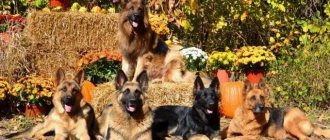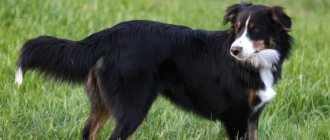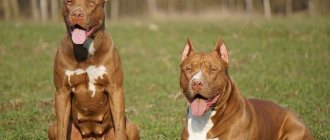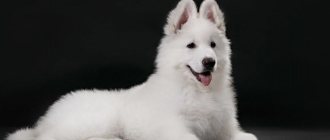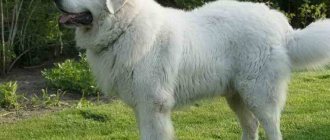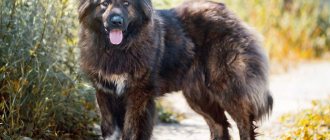Origin of the word shepherd
According to the etymological dictionary, “shepherd” has the same root as the word “sheep.” Shepherd dogs were the dogs that guarded the sheepfold. Schäferhund is translated from German as sheep dog or shepherd dog, which means “flock guard dog.” Thus, the etymology of the word is related to the activity of the animal. The territory of Germany was covered with lush pastures where herds grazed. The word “shepherd dogs” came from someone’s light hand.
A mention of these animals was found in the 7th century. The code of laws of the West German Alemannic tribes provided for punishment for the killing of a shepherd dog.
Where was this breed developed?
In the 18th century Cattle breeding developed rapidly in Germany. There was a need for powerful dogs that could manage a flock. Four-legged shepherds were highly valued. A tendency has emerged to breed dogs with specified performance characteristics. Few people paid attention to the appearance of the animals. The dogs varied greatly in appearance.
Reproduction was placed on a commercial basis; no special standards were put forward. However, two centers for breeding shepherd dogs appeared: Thuringia and Württemberg. These were the names of the most famous kennels, but dogs were bred throughout the German lands. The dogs from the two centers differed in appearance. Thuringian Shepherds had:
- average height;
- wolf color;
- ring tail;
- pointy ears.
Lively, active dogs seemed more attractive compared to the dogs from Württemberg. The latter were more balanced. Dogs of impressive size, with colored spots on their bodies, could have drooping ears. Despite the difference, the owners mated their pets by infusing them with the blood of foreign dogs.
German Shepherd breed standard
Like any breed, shepherds have a certain standard, which indicates the purebred of the animal. The German Shepherd standard includes both a description of appearance and character.
Outwardly, these dogs look neither light nor heavy. They have a strong build. They are distinguished by their roastiness and leanness. A male German Shepherd reaches 600–650 mm at the withers. Bitches are slightly smaller: their height at the withers is 550–600 mm.
As you can see, the height at the withers can vary within a small range. Naturally, such growth is typical for adult animals. However, puppies grow up quite quickly. Therefore, their growth soon reaches the breed standard.
Similar article: What is the difference between a German Shepherd and an Eastern European one and which is better?
If you cross a shepherd with other breeds, the dogs will be less tall than normal. Typically, these puppies are small compared to purebreds. Very small dogs are obtained when shepherds are mated with representatives of small breeds.
The German Shepherd has the following breed description:
- the head is elongated, moderately widened and tapering towards the nose. The muzzle and skull have the same proportions. The skull itself is almost square;
- the jaws are well developed. They are powerful. German Shepherds have a scissor bite;
- the tip of the nose is black. This is part of the breed's characteristics;
- lips are dark. They fit tightly to the jaw;
- the eyes are also dark. They are medium in size and almond-shaped. They are characterized by a slightly oblique arrangement; ears are triangular in shape. They are standing and have medium dimensions. Their ends are slightly pointed;
- the neck is powerful, without dewlap;
- the body is stretched. It slopes slightly towards the croup;
- the back is strong and muscular;
- the sternum is well developed;
- the tail hangs down and has a curve. It is characterized by fluffiness on the inside;
- straight and parallel limbs. Paws are rounded.
The coat is hard and lies tightly to the skin. Dogs have an undercoat. The hair is longest on the neck. The color of animals can be gray, brown or black. It is possible to combine colors and form a pattern (the so-called “mask and cloak”). Of course, it is the multi-colored dogs with patterns that are the most recognizable representatives of this breed. However, you should still know what a German Shepherd looks like in order to determine the breed regardless of its color.
We recommend this article:
What are the characteristics of a black German Shepherd?
An adult male weighs approximately 35–40 kg, and a female weighs 25–32 kg. The height of animals is not tied to weight.
This is the breed standard. It should be detected in any purebred dog belonging to this variety. But that's not all. After all, the German Shepherd in its characteristics of the breed also contains a description of its character, on which the characteristics of education and care depend.
We recommend this article:
Genetics and groups of the long-haired German Shepherd
Max von Stephanitz
The history of the German Shepherd begins in 1899, when retired officer Max von Stefanitz met a dog that combined all the perfection of the breed. Max bought the dog and named him Horand von Grafarth. This dog marked the beginning of the breeding work of the main German Shepherd community.
Max von Stefanitz received his veterinary education. Since childhood, he remembered dogs on vast pastures. He dreamed of breeding the ideal dog - the true embodiment of four-legged shepherds. His biography included an unexpected resignation, but it was this that gave him the opportunity to seriously engage in breeding work. He approached the matter in detail and created the Union of German Shepherd Owners. He was the first who did not seek commercial benefits from breeding shepherd dogs.
The purchased dog was phenomenal not only in appearance. Von Stefanitz was engaged in breeding elite dogs sparing no effort:
- selected bitches to match the main sire;
- traveled around the country looking for material;
- worked with nursery owners, explaining the intricacies of breeding selection.
After 100 years, the Union has become the most impressive organization among similar societies. The standards put forward by Max have gone down in history as benchmarks.
How a shepherd became a service dog
For a long time, a person interacted with a German shepherd only as a shepherd. However, the 19th century became a time of industrialization. The number of pastures was rapidly declining, and the need for flock guards was decreasing.
In 1901, von Stephanitz became the permanent president of the Union. He actively promoted German Shepherds for military and civilian service. The police began to use dogs, and they found a place in the army. This became possible due to the fact that during selection a serious emphasis was placed on the behavioral characteristics of the dogs. The President of the Union opened special competitions for shepherd dogs to secure the status of service dogs with the issuance of awards.
Character and training of the German Shepherd
The peculiarity of the breed is its versatility, ease of maintenance, as well as high intelligence, which allows them to be effectively trained.
Related article: Genetics and groups of the long-haired German Shepherd
Each German Shepherd has an individual character. These animals are self-confident, persistent and brave. They love to demonstrate their skills and therefore are always on the move. Shepherd dogs obey their owners and are infinitely loyal to them. It is best for one person to raise them. They are also good with children.
Animals are highly trainable. You can raise puppies as young as 2 months old.
As already noted, an important distinguishing characteristic of the German Shepherd is high intelligence. Thanks to their intelligence, these dogs have a wide variety of uses today.
We recommend this article:
Weight and height of a German Shepherd puppy by month
Crisis in breeding and a new stage in the history of the origin of the German Shepherd
Thanks to the Union, the breed achieved recognition and spread beyond the country. Unscrupulous owners took advantage of the interest in the dog and deviated from the rules for profit. The blood of defective dogs of non-standard sizes with unstable temperament was poured into the breed. Large dogs were in particular demand.
In the name of saving the line, in 1925 the “Union” held a conference that united the breeders in the desire to return standards. A sample of Champions from different years was taken, of which the best performance was from a male named Claudo von Boxberg. The main genetic branches originated from it. The appearance of this dog marked the boundary between past and future standards. A male chosen among the elite means no less for the development of the line than the legendary Horand.
German Shepherd Nutrition
You need to feed your German Shepherd puppy from a special dish on a stand, since the correct body position while eating is important for the formation of the exterior. The bowl should be positioned so that it is at the level of the baby's chest or slightly higher. When eating, he should only put his face in the bowl. If the puppy has to bend over to eat, he may develop a high rear, a hunchback, and weak pasterns on his front paws.
A double bowl (for food and drink) attached to a stand with height adjustment is ideal. As the puppy grows, you can change the height of the bowl. Feeding utensils can be metal, enamel or clay without chipping so that the baby does not injure his tongue.
The food should not be hot; the puppy can only be fed lukewarm food. After the baby finishes eating, wipe his face with a special clean cloth. Your pet's water should be changed 3-4 times a day to keep it fresh.
When the puppy is 2 months old, he will need to be given some soft, raw bones or calf cartilage. This dish should be offered to the baby after the main meal so as not to interrupt his appetite. Bones are very healthy as they are a good source of minerals. If your pet doesn't like bones, then either they are of poor quality or your puppy has toothache.
Some puppies happily eat raw potatoes and have difficulty digesting boiled ones. Potato starch has a beneficial effect on dog fur.
The puppy can be fed both boiled and raw meat, but raw is preferable, as it is much better digestible and contains more vitamins.
Meat can be given to a puppy from the age of one month, preferably in scraped form: the minced meat sticks together in the dog’s stomach into lumps and is poorly digested, since gastric juice affects only part of the food. From a thick, lean piece of meat, scrape the meat with the edge of a spoon. Up to two months, your pet can be given raw beef and boiled rabbit and chicken meat.
The daily amount of meat should be divided into 3-4 doses.
By-products (heart, liver, etc.) can be given to a puppy no earlier than he is 4 months old. Liver can only be present in your pet's diet in boiled form, as it may contain germs of worms. The heart, lungs and udder are given raw from 6 months, after being crushed. Brains are useful for a puppy if his lipid metabolism is disturbed. By-products cannot replace meat for your pet, so you can give them no more than 2-3 times a week, increasing the norm in relation to meat by 1.5 times.
From 1.5 to 5 months, you should offer your baby large raw beef bones. The puppy will chew them, although he will not be able to chew them. Later, when baby teeth are replaced with permanent ones, these bones will need to be excluded from the diet, since the dog can chew them, and swallowed fragments can injure its stomach or intestines.
From 4 months, you can introduce sea fish into your puppy’s diet, replacing meat with it 1–2 times a week. A serving of fish should be 1.5 times larger than a serving of meat. It is impossible to give fish more often, since an increase in the concentration of substances contained in fish in the dog’s body leads to the destruction of B vitamins, and this is fraught with growth retardation, the appearance of dandruff and indigestion. You can give your puppy raw or cooked fish fillets. You can feed your pet river fish only after boiling it, as it often contains worm larvae.
We advise you to read: Leonberger Dog Breed
Raw eggs are poorly digestible by the dog's body, and raw egg whites even cause the destruction of biotin (vitamin H), which can lead to skin diseases. The raw yolk can be given with milk, and the egg white must be boiled and crushed. Eggs are also well digested by the puppy in the form of a milk omelet.
Your pet needs cottage cheese in its diet, which is a source of highly digestible calcium. Cottage cheese prepared at home is better suited for feeding a puppy.
An adult German Shepherd spends a lot of energy, because most often it lives in the open air and actively works, guarding and protecting its owners or chasing trespassers, and runs a lot. At the same time, dogs have rather low digestive abilities: the ratio of the mass of the gastrointestinal tract to body weight in the German Shepherd is almost half that of small dogs. The owner's main task is to provide the dog with the necessary calories without overloading its stomach. Solution: easily digestible (more than 85%) food and dividing the daily portion of food into two meals
Why the German Shepherd was bred for “sports” breeding
In 1960, selection was carried out quite actively. Training competitions came into fashion and were gaining popularity all over the world. Such competitions required special dogs. The emphasis was on tirelessness, speed and excitement: the exterior did not play a special role.
Since breeders of “sporting” dogs appeared, the society decided to distinguish 2 breed branches: elite dogs and working dogs. For elite breeding animals, checks were required for:
- absence of physical abnormalities;
- resistance to loads;
- equilibrium;
- exterior;
- correspondence to origin.
The latter is verified by DNA analysis. The value of sporting dogs was marked by the number of victories in competitions; they did not need beauty.
New requirements for Breed Champions
In the 80s A high-level professional, Herman Martin, came to the post of President of the Union. Along with it came new requirements for the championship title. Now it was impossible to get a championship by visiting the exposition. In addition to the basic requirements, the dog had to:
- participate in shows more than once;
- regularly withstand expert tests;
- give worthy offspring.
Why was multi-year selection necessary? This excluded random animals from entering the elite group, since the status was confirmed many times.
In what year did German shepherds appear in Russia?
The breed appeared in Russia not by chance. German Shepherds were brought in in 1904 as potential ambulance dogs. They distinguished themselves during the Russo-Japanese War. In 1908, the animals took part in police dog competitions along with Doberman Pins.
German Shepherds in the USSR
After the revolution in 1924, a large batch of representatives of the breed were brought to the USSR for the needs of the NKVD and border troops. The project was not very successful, since it coincided with the canine crisis of the 20s. Animals that fall outside the breeding standards have entered the country. They had defects in their exterior and could be angry or cowardly, which German dog handlers did not allow. The lack of competent breeders, unsystematic crossing and poor material did not allow the breeding of dogs of Western standards.
How did the Great Patriotic War influence the development of the breed in Russia?
After the war, an order was received to breed dogs for use in the Soviet Army. However, during this period, the homeland of the German Shepherd was closed to Soviet dog handlers, so it was necessary to work with the remaining dogs and dogs left by the Germans during the retreat, and it’s hard to even imagine what kind of animals could be found in the “ruins” of the terrible war.
In addition to the lack of worthy samples, there were also difficulties:
- negative attitude of people towards the definition of “German”;
- the role of dogs in guarding concentration camps and punitive squads.
In 1946, the breed was named the East European Shepherd to break away from bad associations. The lack of business contacts with the Germans caused damage to selection: the breed was bred deviating from European standards.
Caring for a German Shepherd
A German Shepherd only needs to be brushed about twice a week. If the German Shepherd's coat is not regularly groomed, there will be a lot of short, dark hair in the house, and their undercoat, especially on the belly and neck, will become matted. Find a brush that removes hair well and that your dog likes.
Sometimes you can trim the long hair on your dog's back legs to keep it from tangling.
It is better to bathe German Shepherds not often, once or twice a year. Frequent bathing can cause the coat to lose its natural oils and become dull. When bathing, it is very effective to use a brush, which will help rid your dog of a lot of excess hair after bathing.
At the age of 1.5 months, the puppy tries to chew everything it comes across. Make sure that the baby has no way to get to electrical and telephone wires, as well as to room slippers. The puppy should not play with shoes under any circumstances, otherwise, when he grows up, they will constantly suffer from his teeth. Do not let your pet chew on rubber objects, as he may swallow the bitten pieces, which can have serious consequences. There are many known cases where such moments led to the death of puppies.
Sometimes your puppy may start chewing on legs or other wooden parts of furniture. In this case, you can give him dried pig ears or a piece of a thick linden branch, dipping it in natural wood glue and drying it. It is also useful to give your baby carrots or apples as toys: he will not only satisfy his innate need to chew, but will also receive a small portion of vitamins.
We advise you to read: Chow Chow Dog Breed
During the teething period, prepare special toys for your baby that he can play with for a long time. For example, cast rubber balls, calcined pure brain bones, or specially made imitations of them.
The German Shepherd is distinguished by its long development: the dog becomes fully mature by the age of three. The puppy grows quickly and appears to be an adult dog, but requires careful handling. When playing games, do not take away a toy or ball from him, so as not to spoil his bite or damage his teeth. Do not pet the puppy on the head and ears: the ear cartilages are still weak, and the ears may not take the desired standing position.
German Shepherds are strong and athletic dogs and require significant exercise. A large running yard and daily walks keep German Shepherds in good physical shape. Their intelligence requires constant mental stress, so training for such dogs is really necessary. In addition, it provides them with sufficient physical activity.
The German Shepherd is very suitable for people who love sports and lead an active lifestyle. She is quite capable of hiking in the forest or in the mountains, jogging for many kilometers next to you, and even behind a bicycle. The latter, by the way, is a very good way to train a German Shepherd. The main thing is not to overload your pet in hot weather and begin such training no earlier than the puppy turns one year old.

